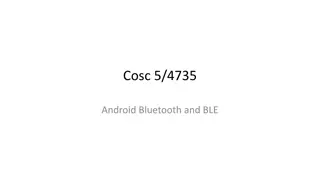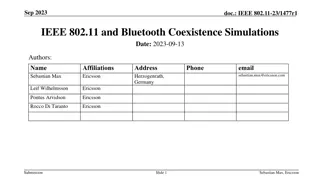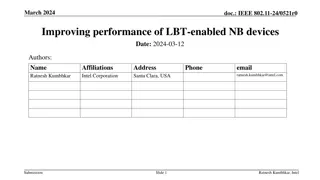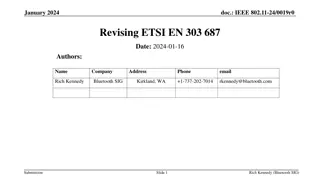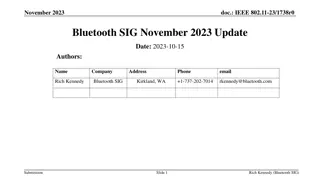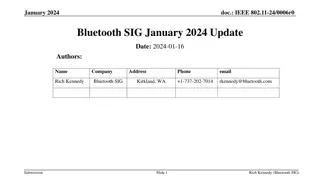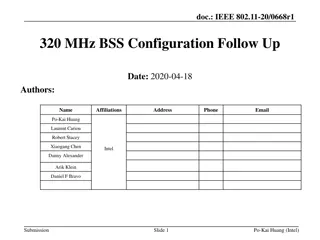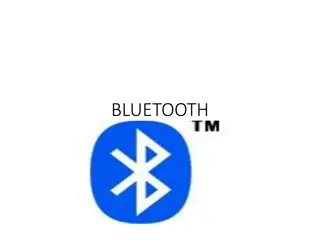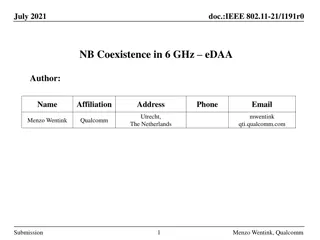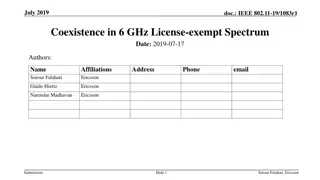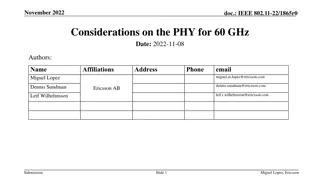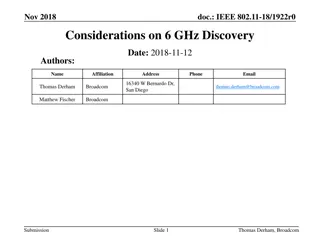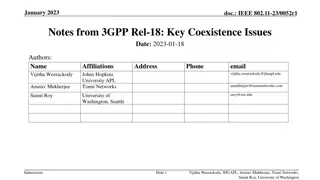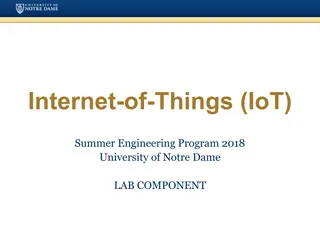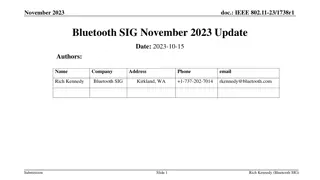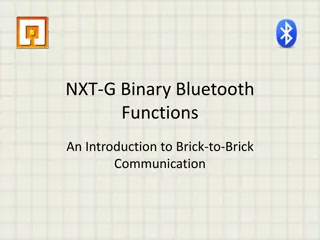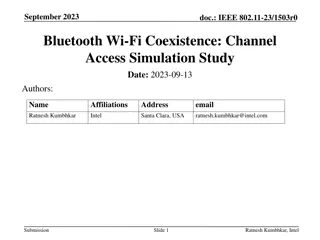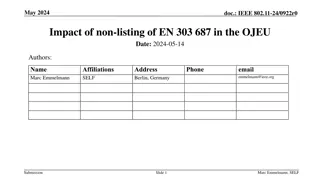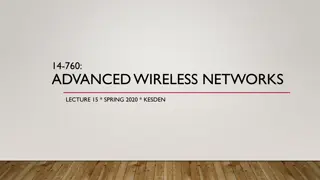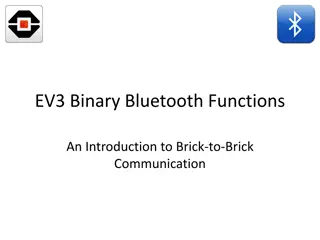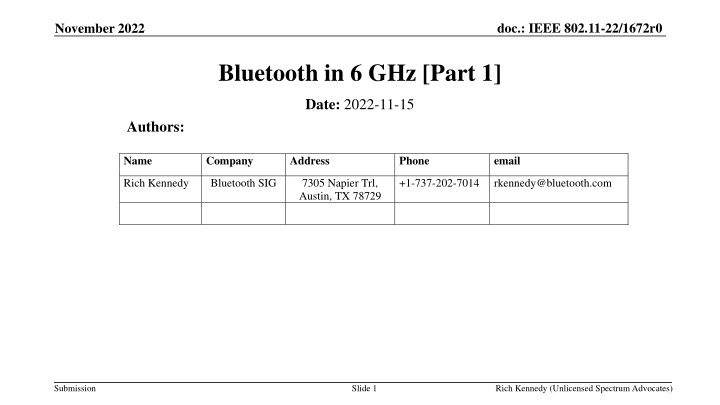
Bluetooth Technology Expansion into 6 GHz Spectrum
"Discover the potential of Bluetooth technology expanding into the 6 GHz spectrum to enhance performance, coexist with IEEE 802.11, and unlock new markets. Learn about the history, current status, and future prospects of Bluetooth in this innovative shift."
Download Presentation

Please find below an Image/Link to download the presentation.
The content on the website is provided AS IS for your information and personal use only. It may not be sold, licensed, or shared on other websites without obtaining consent from the author. If you encounter any issues during the download, it is possible that the publisher has removed the file from their server.
You are allowed to download the files provided on this website for personal or commercial use, subject to the condition that they are used lawfully. All files are the property of their respective owners.
The content on the website is provided AS IS for your information and personal use only. It may not be sold, licensed, or shared on other websites without obtaining consent from the author.
E N D
Presentation Transcript
doc.: IEEE 802.11-22/1672r0 November 2022 Bluetooth in 6 GHz [Part 1] Date: 2022-11-15 Authors: Name Company Address Phone email Rich Kennedy Bluetooth SIG 7305 Napier Trl, Austin, TX 78729 +1-737-202-7014 rkennedy@bluetooth.com Submission Slide 1 Rich Kennedy (Unlicensed Spectrum Advocates)
doc.: IEEE 802.11-22/1672r0 November 2022 Abstract Currently, over 5 billion Bluetooth enabled devices are sold each year. This success is large part due to continued performance enhancements made to Bluetooth technology over the last 20+ years. To continue those enhancements, Bluetooth needs to expand its operation beyond the 83.5 MHz of spectrum in the 2.4 GHz band. With between 480 and 1200 MHz of license- exempt/unlicensed shared spectrum in the 6 GHz band, this narrowband technology can coexist with IEEE 802.11 technologies to the benefit of both. Submission Slide 2 Rich Kennedy (Unlicensed Spectrum Advocates)
doc.: IEEE 802.11-22/1672r0 November 2022 Agenda The History of Bluetooth Bluetooth Today WAS/RLAN in 6 GHz Bluetooth and IEEE 802.11 Coexistence Sharing Makes Sense Solutions is What We Do! Submission Slide 3 Rich Kennedy (Unlicensed Spectrum Advocates)
doc.: IEEE 802.11-22/1672r0 November 2022 Bluetooth Today: The leading global wireless standard for device communications and positioning Annual Wireless Product Shipments billions 8 7 6 5 4 3 2 1 0 2017 2018 2019 2020 2021 2022 2023 2024 2025 2026 Sources: ABI Research, Bluetooth SIG, Inc. Submission
doc.: IEEE 802.11-22/1672r0 November 2022 Bluetooth Today: >20-year track record of performance enhancements that have enabled massive new markets Submission
doc.: IEEE 802.11-22/1672r0 November 2022 WAS/RLAN in 6 GHz In 2017, a coalition of companies with an interest in expanding Wi-Fi to another frequency band to support innovation and to enable operation in less congested spectrum, requested ECC FM57 to consider the 6 GHz band Apple, Broadcom, Cisco, Facebook, Google, Hewlett-Packard Enterprise, Intel, MediaTek, Microsoft and Qualcomm The European Commission issued an Implementing Decision in June 2021 to make 5945 6425 MHz open for license-exempt sharing: [E]very EU member state must update their national frequency allocation plans to reflect the 6 GHz decision before December 1, 2021 The FCC started an NPRM in October of 2018: Unlicensed Use of the 6 GHz Band spun off from a proceeding on Expanding Flexible Use in Mid-Band Spectrum Between 3.7 and 24 GHz Supported by the same coalition, the FCC issued a first R&O in April 2020 Global* support is slowly become a reality *WRC23 will decide if this band should be declared as IMT spectrum, the outcome of which countries such as China are waiting for. Submission Slide 8 Rich Kennedy (Unlicensed Spectrum Advocates)
doc.: IEEE 802.11-22/1672r0 November 2022 Bluetooth and IEEE 802.11 Coexistence Bluetooth sharing with Wi-Fi in 2.4 GHz e.g. Adaptive Frequency Hopping Spread Spectrum and in-device coordination Sharing methods have been developed and enhanced over the years Innovation in both IEEE 802.11 and Bluetooth will adapt to new 6 GHz band uses to support innovation and to enable operation in less congested spectrum Both organizations have the experience and know-how to coexist in 6 GHz Regulators have a responsibility to be technology neutral Collaboration between the two most prolific wireless technologies is essential Submission Slide 9 Rich Kennedy (Unlicensed Spectrum Advocates)
doc.: IEEE 802.11-22/1672r0 November 2022 Sharing Makes Sense IEEE 802.11 proponents took on the incumbents starting in 2017 to gain regulatory approval to share the 6 GHz band Significant industry support in an industry coalition to drive required regulatory changes Regulators world-wide recognized the need to support the growth of Wi-Fi based on how the limitations of the 2.4 and 5 GHz bands would stifle innovations Bluetooth is currently shipping over 5 billion devices per year; 7 per year billion by 2026 Congestion in the 83.5 MHz of spectrum in the 2.4 GHz band not only limits technology innovation but may eventually make critical application less reliable; reminiscent of the Wi-Fi story Regulators will not favor one unlicensed/license-exempt technology over another ETSI has already begun the process of incorporating narrow band technology in the 6 GHz harmonized standard (EN 303 687) For many years Bluetooth and Wi-Fi have successfully shared the 2.4 GHz band If we collaborate on this effort both technologies will win Submission Slide 10 Rich Kennedy (Unlicensed Spectrum Advocates)
doc.: IEEE 802.11-22/1672r0 November 2022 Solutions Is What We Do! The Bluetooth SIG is committed to sharing the 6 GHz band with minimal impact on Wi-Fi Collaborating with both IEEE 802.11 and Wi-Fi Alliance we believe this will be a win-win Together at IEEE 802.11 Together at ETSI BRAN Together at the FCC, etc. Supporting the global growth of 6 GHz band unlicensed allocations together Submission Slide 11 Rich Kennedy (Unlicensed Spectrum Advocates)
doc.: IEEE 802.11-22/1672r0 November 2022 References COMMISSION IMPLEMENTING DECISION (EU) 2021/1067 of 17 June 2021 on the harmonised use of radio spectrum in the 5 945-6 425MHz frequency band for the implementation of wireless access systems including radio local area networks (WAS/RLANs) https://eur-lex.europa.eu/legal-content/EN/TXT/HTML/?uri=CELEX:32021D1067&from=EN Submission Slide 12 Rich Kennedy (Unlicensed Spectrum Advocates)

